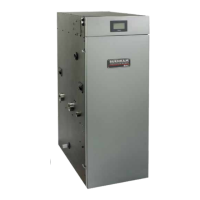77
H. Purge Air From Gas Train
Upon initial start-up, the gas train will be lled with air.
Even if the gas line has been completely purged of air,
it may take several tries for ignition before a ame is
established. If more than 5 tries for ignition are needed,
it will be necessary to press the reset button to restart
the boiler. Once a ame has been established for the
rst time, subsequent calls for burner operation should
result in a ame on the rst try.
I. Check Burner Flame
Inspect the ame visible through the window. On high
re the ame should be stable and mostly blue (Figure
52). No yellow tipping should be present; however,
intermittent ecks of yellow and orange in the ame are
normal.
J. Check Gas Inlet Pressure
Check the inlet pressure and adjust if necessary. Verify
that the inlet pressure is between the upper and lower
limits shown on the rating plate with all gas appliances
on and off.
WARNING
The outlet pressure for the gas valve has been
factory set and requires no eld adjustment. This
setting is satisfactory for both natural gas and
propane. Attempting to adjust the outlet pressure
may result in damage to the gas valve and cause
property damage, personal injury or loss of life.
K. For LP Gas, perform procedure as described in
Paragraph R “Field Conversion From Natural Gas to LP
Gas” before starting Paragraph L “Checking/Adjusting
Gas Input Rate”.
For natural gas, proceed to Paragraph L “Checking/
Adjusting Gas Input Rate”.
L. Checking /Adjusting Gas Input Rate
1. Turn off gas supply to all appliances other than gas-
red boiler.
2. Light main burner by adjusting thermostat to highest
setting.
3. Clock gas meter for at least two (2) revolutions
of the dial typically labeled ½ or 1 cubic foot per
revolution on a typical gas meter.
4. Determine gas ow rate in Cubic Feet per Hour
based on elapsed time for two revolutions.
Example:
Using a meter with dial labeled 1 cubic foot per
revolution, measured time is 72 Seconds for (2)
Revolutions, i.e. 36 seconds per 1 cubic foot.
Calculate hourly gas ow rate:
3600 sec/hr ÷ 36 sec/cu ft = 100 cu ft/hr
5. Obtain gas-heating value (Btu per cubic foot) from
gas supplier.
6. Multiply hourly gas ow rate by gas heating value
to determine the boiler input rate, BTU/hr
Example:
Natural gas heating value provided by local gas
utility is 1050 Btu per cubic foot.
Measured and calculated hourly gas ow rate is 100
cu ft/hr.
Measured boiler input rate is:
100 cu ft/hr * 1050 BTU/ cu ft = 105, 000 BTU/hr
7. Compare measured input rate to input rate value
stated on rating label. Strive to adjust the boiler
input rate within 88% to 100% of the value listed on
the boiler rating label.
8. If measured input is too high, reduce input rate by
rotating gas valve throttle screw clockwise (see
Figure 53) in ¼ turn increments and checking the
rate after every adjustment until the measured
input rate value falls within 88% to 100% of the
IX. System Start-up (continued)
Status Control Action
Initiate Power-up
Standby Delay
This state is entered when a delay is
needed before allowing the burner control
to be available and for sensor errors.
Standby
Boiler is not ring. There is no call for
heat or there is a call for heat and the
temperature is greater than setpoint.
Safe Startup
Tests ame circuit then checks for ame
signal.
Drive Purge
Driving blower to purge rate setting and
waiting for the proper fan feedback.
Prepurge
Purges the combustion chamber for the
10 second purge time.
Drive Light-off
Driving blower to light-off rate setting and
waiting for the proper fan feedback.
Pre-ignition
Test
Tests the safety relay and veries that
downstream contacts are off.
Pre-ignition
Energizes the igniter and checks for
ame.
Direct
Ignition
Opens main fuel valve and attempts
to ignite the main fuel directly from the
ignition source.
Running
Normal boiler operation. Modulation rate
depends on temperature and setpoint
selections and modulating control action.
Postpurge
Purges the combustion chamber for the
30 second purge time.
Lockout
Prevents system from running due to a
detected problem and records fault in
Lockout History.

